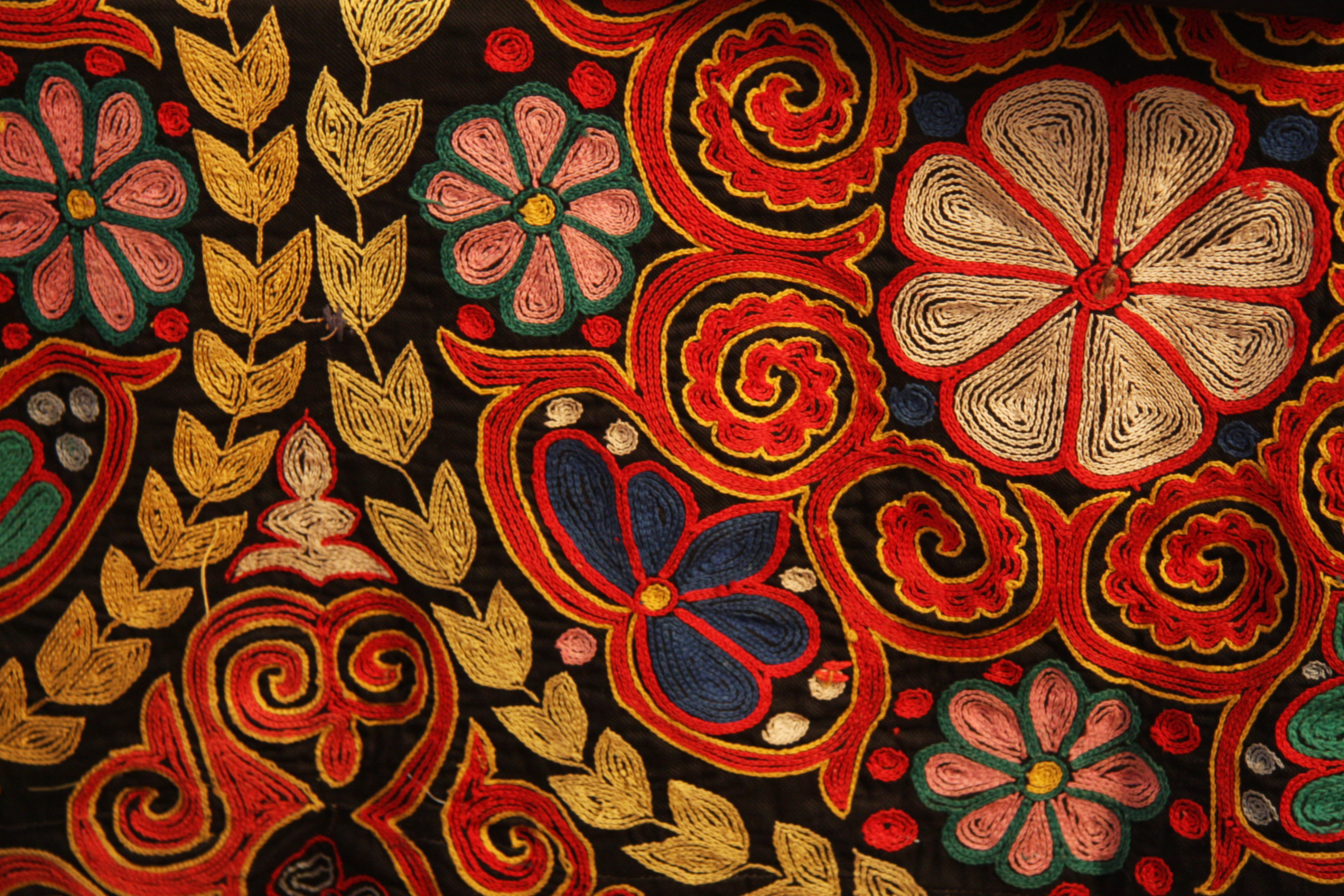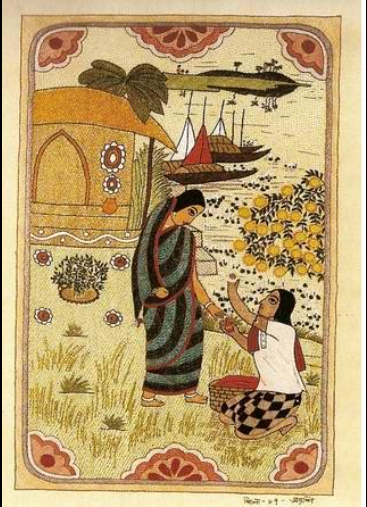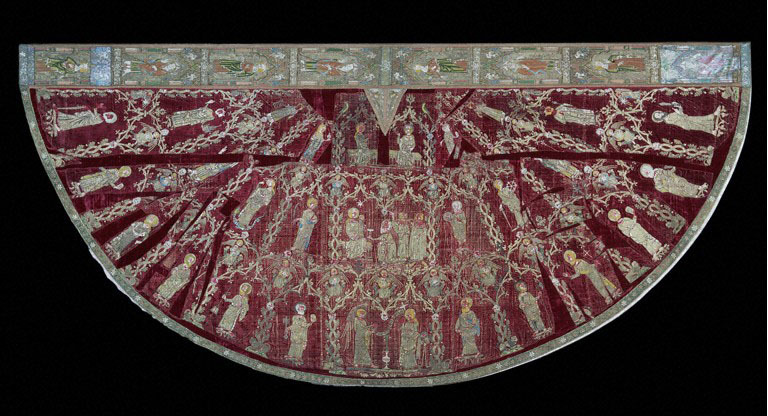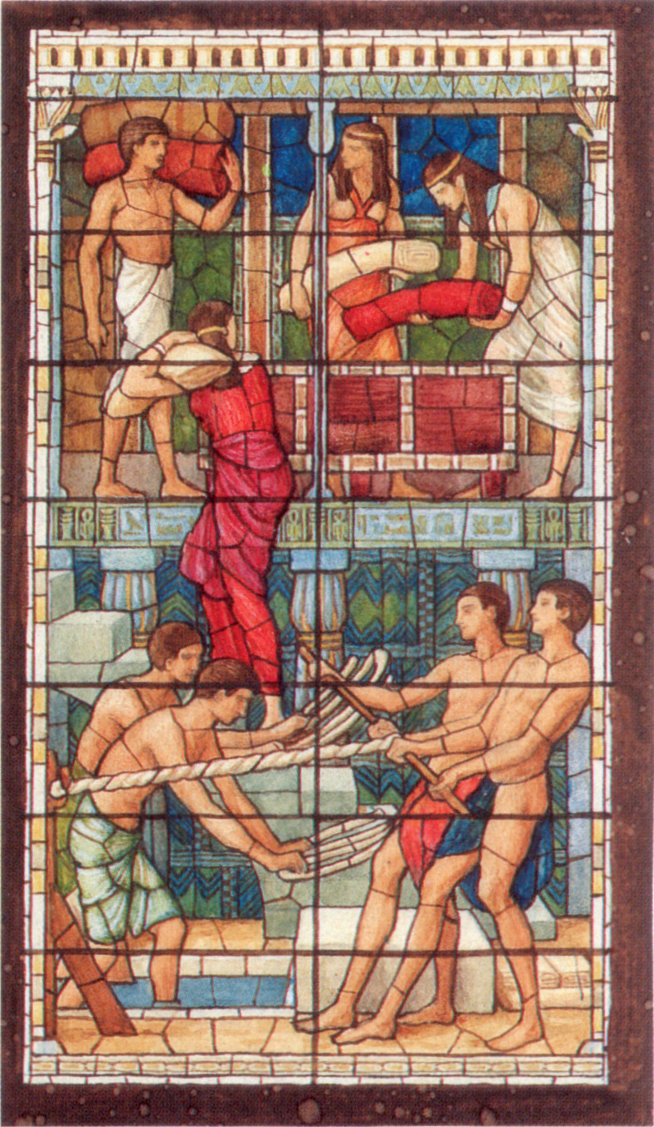|
Embroidery
Embroidery is the art of decorating Textile, fabric or other materials using a Sewing needle, needle to stitch Yarn, thread or yarn. It is one of the oldest forms of Textile arts, textile art, with origins dating back thousands of years across various cultures. Common Embroidery stitch, stitches found in early embroidery include the chain stitch, Buttonhole stitch, buttonhole or blanket stitch, running stitch, satin stitch, and cross stitch. Modern embroidery continutes to utilize traditional techniques, though many contemporary stitches are exclusive to machine embroidery. Embroidery is commonly used to embellish accessories and garments is usually seen on quilts, clothing, and accessories. In addition to thread, embroidery may incorporate materials such as Pearl, pearls, Bead, beads, Quill, quills, and Sequin, sequins to highlight texture and design. Today, embroidery serves both decorative and functional purposes and is utilized in fashion expression, cultural identity, and ... [...More Info...] [...Related Items...] OR: [Wikipedia] [Google] [Baidu] |
Cross Stitch
Cross-stitch is a form of sewing and a popular form of counted-thread embroidery in which X-shaped stitches (called cross stitches) in a tiled, raster-like pattern are used to form a picture. The stitcher counts the threads on a piece of evenweave fabric (such as linen) in each direction so that the stitches are of uniform size and appearance. This form of cross-stitch is also called counted cross-stitch in order to distinguish it from other forms of cross-stitch. Sometimes cross-stitch is done on designs printed on the fabric (stamped cross-stitch); the stitcher simply stitches over the printed pattern. Cross-stitch is often executed on easily countable fabric called aida cloth, whose weave creates a plainly visible grid of squares with holes for the needle at each corner. Fabrics used in cross-stitch include linen, aida cloth, and mixed-content fabrics called 'evenweave' such as jobelan. All cross-stitch fabrics are technically "evenweave" as the term refers to the fact t ... [...More Info...] [...Related Items...] OR: [Wikipedia] [Google] [Baidu] |
Chain Stitch
Chain stitch is a sewing and embroidery technique in which a series of looped stitches form a chain-like pattern. Chain stitch is an ancient craft – examples of surviving Chinese chain stitch embroidery worked in silk thread have been dated to the Warring States period (5th – 3rd century BC). Handmade chain stitch embroidery does not require that the needle pass through more than one layer of fabric. For this reason the stitch is an effective surface embellishment near seams on finished fabric. Because chain stitches can form flowing, curved lines, they are used in many surface embroidery styles that mimic "drawing" in thread. Chain stitches are also used in making tambour lace, needlelace, macramé and crochet. In Azerbaijan, in the Sheki region, this ancient type of needlework is called ''tekeldus''. History The earliest archaeological evidence of chain stitch embroidery dates from 1100 BC in China. Excavated from royal tombs, the embroidery was made using thr ... [...More Info...] [...Related Items...] OR: [Wikipedia] [Google] [Baidu] |
Embroidery Stitch
In everyday language, a stitch in the context of embroidery or hand-sewing is defined as the movement of the embroidery Sewing needle, needle from the back of the fibre to the front side and back to the back side. The thread stroke on the front side produced by this is also called ''stitch''. In the context of embroidery, an embroidery stitch means one or more ''stitches'' that are always executed in the same way, forming a figure. Embroidery stitches are also called ''stitches'' for short. Embroidery stitches are the smallest units in embroidery. Embroidery patterns are formed by doing many embroidery stitches, either all the same or different ones, either following a counting chart on paper, following a design painted on the fabric or even working freehand. Common stitches Embroidery uses various combinations of stitches. Each embroidery stitch has a special name to help identify it. These names vary from country to country and region to region. Some of the basic stitches of ... [...More Info...] [...Related Items...] OR: [Wikipedia] [Google] [Baidu] |
Running Stitch
The straight or running stitch is the basic Stitch (textile arts), stitch in hand-sewing and embroidery, on which all other forms of sewing are based. The stitch is worked by passing the Sewing needle, needle in and out of the textile, fabric at a regular distance. All other stitches are created by varying the straight stitch in length, spacing, and direction. Some sources only use the term straight stitch to refer to the individual stitch or its family of related stitches, while others use it interchangeably with or in place of running stitch. Running stitch will never be used to refer to a single stitch since a single running stitch is a straight stitch. Running stitches are most often not visible as they are used to close Seam (sewing), seams. Running stitch, Holbein stitch, Holbein or double-running stitch, satin stitch and darning stitch are all classed as straight or flat stitches. Backstitch is also sometimes included in this category.Enthoven, Jacqueline: ''The ... [...More Info...] [...Related Items...] OR: [Wikipedia] [Google] [Baidu] |
Satin Stitch
In sewing and embroidery, a satin stitch or damask stitch is a series of flat stitches that are used to completely cover a section of the background fabric. Narrow rows of satin stitch can be executed on a standard sewing machine using a zigzag stitch or a special satin stitch foot. In order to maintain a smooth edge, shapes can be outlined with back, split or chain stitch before the entire shape including the outline is covered with satin stitch. In traditional practice, satin stitch is employed to fill an area without the presence of an outline, resulting in smooth shapes and even lines created by the stitching. Machine-made satin stitch is often used to outline and attach appliques to the ground fabric. Geography The satin stitch is a common form of needlework traditions worldwide; it is notable in North Africa, South America, Western Asia, Southeast Asia, the Indian subcontinent, and the Middle East. Satin stitch is also characteristic of Chinese embroidery. China ... [...More Info...] [...Related Items...] OR: [Wikipedia] [Google] [Baidu] |
Kantha (Quilt) LACMA AC1994
Kantha (Bengali: wikt:কাঁথা, কাঁথা; Hindi: wikt:कान्था, कान्था), also spelled kanta or qanta, is a type of embroidery craft in Bangladesh and eastern regions of India, particularly in the States and union territories of India, Indian states of West Bengal, Tripura and Odisha. In Odisha, old saris are stacked on each other and hand-stitched to make a thin piece of cushion. This is normally used above a bed cushion or instead of a cushion. Kantha saris are traditionally worn by women in the Bengal region. In the modern day, embroidery is stitched, popularly known as 'kantha stitched", on sari, kurta (or panjabi) and churidar and many other garments and gaining popularity due to their aesthetic value and handmade characteristics. Kantha stitching is also used to make simple quilts, commonly known as nakshi kantha. Women in Bengal typically use old saris and cloth and layer them with kantha stitching to make a light blanket, throw, or beds ... [...More Info...] [...Related Items...] OR: [Wikipedia] [Google] [Baidu] |
Opus Anglicanum
Opus Anglicanum or English work is fine needlework of Medieval England done for ecclesiastical or secular use on clothing, hangings or other textiles, often using gold and silver threads on rich velvet or linen grounds. Such English embroidery was in great demand across Europe, particularly from the late 12th to mid-14th centuries and was a luxury product often used for diplomatic gifts. Uses Most of the surviving examples of Opus Anglicanum were designed for liturgical use. These exquisite and expensive embroidery pieces were often made as vestments, such as copes, chasubles and orphreys, or else as antependia, shrine covers or other church furnishings. Secular examples, now known mostly just from contemporary inventories, included various types of garments, horse-trappings, book covers and decorative hangings. Manufacture Opus Anglicanum was usually embroidered on linen or, later, velvet, in split stitch and couching with silk and gold or silver-gilt thread. Gold-wound t ... [...More Info...] [...Related Items...] OR: [Wikipedia] [Google] [Baidu] |
Buttonhole Stitch
Buttonhole stitch and the related blanket stitch are hand-sewing stitches used in tailoring, embroidery, and needle lace-making. Applications Traditionally, this stitch has been used to secure the edges of buttonholes. In addition to reinforcing buttonholes and preventing cut fabric from raveling, buttonhole stitches are used to make stems in crewel embroidery, to make sewn eyelets, to attach applique to ground fabric, and as couching stitches. Buttonhole stitch scallops, usually raised or padded by rows of straight or chain stitches, were a popular edging in the 19th century. Buttonhole stitches are also used in cutwork, including Broderie Anglaise, and form the basis for many forms of needlelace. This stitch is well represented on 16th- and 17th-century whitework items. The buttonhole stitch appeared on the Jane Bostocke sampler (1598) which is the earliest, signed sampler known to date and is presently housed in the Victoria and Albert Museum The Victoria and Al ... [...More Info...] [...Related Items...] OR: [Wikipedia] [Google] [Baidu] |
Textile
Textile is an Hyponymy and hypernymy, umbrella term that includes various Fiber, fiber-based materials, including fibers, yarns, Staple (textiles)#Filament fiber, filaments, Thread (yarn), threads, and different types of #Fabric, fabric. At first, the word "textiles" only referred to woven fabrics. However, weaving is not the only manufacturing method, and many other methods were later developed to form textile structures based on their intended use. Knitting and Nonwoven, non-woven are other popular types of fabric manufacturing. In the contemporary world, textiles satisfy the material needs for versatile applications, from simple daily clothing to Bulletproof vest, bulletproof jackets, spacesuits, and Medical gown, doctor's gowns. Textiles are divided into two groups: consumer textiles for domestic purposes and technical textiles. In consumer textiles, Aesthetics (textile), aesthetics and Textile performance#Comfort, comfort are the most important factors, while in techn ... [...More Info...] [...Related Items...] OR: [Wikipedia] [Google] [Baidu] |
Textile Arts
Textile arts are arts and crafts that use fiber crop, plant, Animal fiber, animal, or synthetic fibers to construct practical or decorative Physical object, objects. Textiles have been a fundamental part of human life since the beginning of civilization. The methods and materials used to make them have expanded enormously, while the functions of textiles have remained the same, there are many functions for textiles. Whether it be clothing or something decorative for the house/shelter. The history of textile arts is also the history of international trade. Tyrian purple dye was an important trade good in the ancient Mediterranean. The Silk Road brought China, Chinese silk to India, Africa, and Europe, and, conversely, Sogdian art#Textile arts, Sogdian silk to China. Tastes for imported luxury fabrics led to sumptuary laws during the Middle Ages and Renaissance. The Industrial Revolution was shaped largely by innovation in textiles technology: the cotton gin, the spinning jenn ... [...More Info...] [...Related Items...] OR: [Wikipedia] [Google] [Baidu] |
Sewing Needle
A sewing needle, used for hand-sewing, is a long slender tool with a pointed tip at one end and a hole (or ''eye'') to hold the sewing thread. The earliest needles were made of bone or wood; modern needles are manufactured from high carbon steel wire and are nickel- or gold, 18K gold-plated for corrosion resistance. High-quality embroidery needles are plated with two-thirds platinum and one-third titanium alloy. Traditionally, needles have been kept in needle books or needlecases which have become objects of adornment. Sewing needles may also be kept in an étui, a small box that held needles and other items such as scissors, pencils and tweezers. Types of hand sewing needles Hand-sewing needles come in a variety of types/classes designed according to their intended use. With each type also varying in size. * Sharp needles: used for general hand sewing; built with a sharp point, a round eye, and are of medium length. Those with a double-eyes are able to carry two strands of th ... [...More Info...] [...Related Items...] OR: [Wikipedia] [Google] [Baidu] |
Yarn
Yarn is a long continuous length of interlocked fibres, used in sewing, crocheting, knitting, weaving, embroidery, ropemaking, and the production of textiles. '' Thread'' is a type of yarn intended for sewing by hand or machine. Modern manufactured sewing threads may be finished with wax or other lubricants to withstand the stresses involved in sewing. Embroidery threads are yarns specifically designed for needlework. Yarn can be made of a number of natural or synthetic materials, and comes in a variety of colors and thicknesses (referred to as "weights"). Although yarn may be dyed different colours, most yarns are solid coloured with a uniform hue. Etymology The word " yarn" comes from Middle English, from the Old English , akin to Old High German ', "yarn", Dutch ', Ancient Greek (''chordē'', "string"), and Sanskrit , "band". It originally referred to entrails. History The human production of yarn is known to have existed since the Stone Age and earlier p ... [...More Info...] [...Related Items...] OR: [Wikipedia] [Google] [Baidu] |










